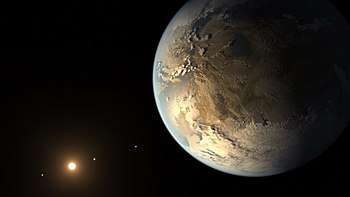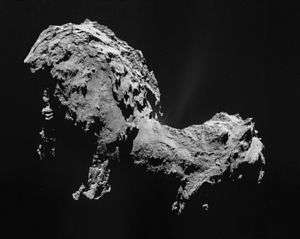C/2014 E2 (Jacques)
C/2014 E2 (Jacques), provisionally designated as S002692,[2] is a long-period comet discovered by the Brazilian astronomers Cristóvão Jacques Lage de Faria, Eduardo Pimentel and João Ribeiro de Barros on the night of 13 March 2014.[3] It was the second comet discovered by the SONEAR Observatory team after comet C/2014 A4.
.jpg) Image of 2014 E2 (Jacques) in 24 August 2014 | |
| Discovery | |
|---|---|
| Discovered by | Cristóvão Jacques Eduardo Pimentel João Ribeiro de Barros |
| Discovery date | 13 March 2014 |
| Orbital characteristics [Heavens AboveIAU Minor Planet Center A] | |
| Epoch | 2014 May 23.0 TT (JD 2456800.5) |
| Aphelion | ~1600 AU (epoch 1950)[1] |
| Perihelion | 0.6638 AU (q) |
| Eccentricity | 0.99912 (e) |
| Orbital period | ~22,000 years inbound (Barycentric solution for epoch 1950)[1] ~12,000 years outbound (Barycentric solution for epoch 2050)[1] |
| Avg. orbital speed | 27 km/s |
| Max. orbital speed | 51.7 km/s |
| Inclination | 156.4° (i) |
| Last perihelion | 2014 July 2 |
Overview
Observations were made with a 0.45-meter (17.7-inch) f/2.9 wide-field reflector telescope with equatorial assembly and CCD camera at the Southern Observatory for Near Earth Asteroids Research (SONEAR), located near Oliveira, Minas Gerais, Brazil.[4]
In late March 2014, C/2014 E2 (Jacques) appeared to contain a dense, bright coma (11.5-12 magnitude), visible with an 8-inch telescope.[4] It crossed the celestial equator on 8 May 2014 becoming a northern hemisphere object.[5] From 3 June 2014 until 17 July 2014 it had an elongation less than 30 degrees from the Sun.[5] The comet was visible in LASCO C3 on 21 June 2014.[6] C/2014 E2 peaked around apparent magnitude 6 in mid-July and was visible in binoculars above the glow of morning twilight.[7][8]
C/2014 E2 passed 0.085 AU (12,700,000 km; 7,900,000 mi) from Venus on 13 July 2014.[9] On 20 July 2014 the comet was near the naked eye star Beta Tauri.[10] On 22 August 2014 it passed Epsilon Cassiopeiae. It reached perigee (closest approach to Earth) on 28 August 2014, at 0.56 AU (84,000,000 km; 52,000,000 mi).[2] The comet passed about 3 degrees from Deneb from 4–5 September 2014.[11] On 14 September the comet was near Albireo.[12]
By October 2014 the comet had fainted to magnitude 10.[13]
References
- Horizons output. "Barycentric Osculating Orbital Elements for Comet C/2014 E2 (Jacques)". (Solution using the Solar System Barycenter and barycentric coordinates. Select Ephemeris Type:Elements and Center:@0)
- "C/2014 E2 Jacques" (in Portuguese). Costeira1 e Cometas/REA. Retrieved 2014-03-31.
- Villamarin, Jenalyn (2014-03-17). "2014 Comet Jacques: SONEAR Team in Brazil Spots New Comet C/2014 E2, Closest Approach to the Sun to Occur on June 29". International Business Times AU. Retrieved 2014-03-31.
- King, Bob (2014-03-15). "New Comet Jacques May Pass 8.4 million miles from Venus this July". Universe Today. Retrieved 2014-03-31.
- "Elements and Ephemeris for C/2014 E2 (Jacques)". The International Astronomical Union Minor Planet Center. Archived from the original on 2014-10-26. Retrieved 2014-06-15.
- Rob Kaufman – comets-ml
- Yoshida, Seiichi (2014-07-20). "Weekly Information about Bright Comets (2014 July 19: North)". aerith.net. Retrieved 2014-10-21.
- Seiichi Yoshida. "C/2014 E2 ( Jacques )". Seiichi Yoshida's Comet Catalog. Retrieved 2014-06-15.
- "JPL Close-Approach Data: C/2014 E2 (Jacques)" (last observation: 2014-10-05; arc: 206 days). Retrieved 2014-04-30.
- "Catch Comet Jacques near Venus at dawn". AstroBob. 2014-07-15. Retrieved 2014-07-20.
- https://www.flickr.com/photos/47833278@N02/14962858201/
- David Dickinson (2014-09-09). "Tales (Tails?) Of Three Comets". Universe Today. Retrieved 2014-09-12.
- Yoshida, Seiichi (2014-10-05). "Weekly Information about Bright Comets (2014 Oct. 4: North)". aerith.net. Retrieved 2014-10-21.
External links
| Wikimedia Commons has media related to C/2014 E2. |
- Comet C/2014 E2 (Jacques) live data - The Sky Live
- Ephemeris for C/2014 E2 (Jacques) - The International Astronomical Union
- Comet C/2014 E2 (Jacques) at CometBase
- Image of Comet Jacques - YouTube (March 2014)
- C/2014 E2 disconnection event and Venus as seen by STEREO HI-2A
- 2014 E2 (11 July 2014)
- Comet Jacques imaging opportunities




